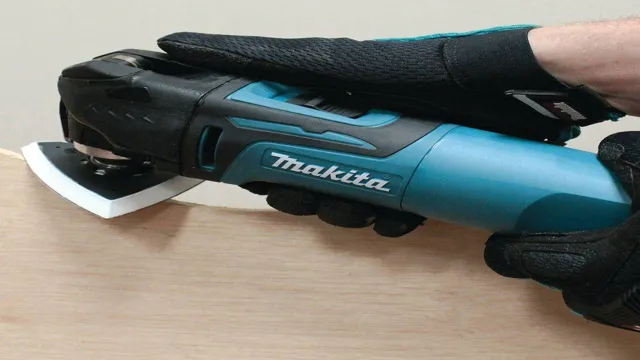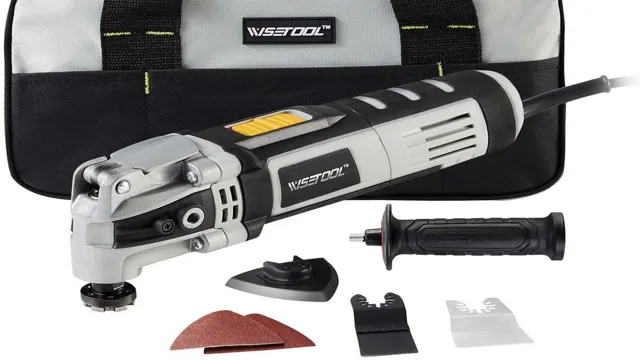What to Use Oscillating Multi Tool for: 10 Essential Tasks for Homeowners

If you’re a DIY enthusiast or professional handyman, you’ll find that an oscillating multi-tool is a versatile and indispensable piece of equipment. But if you’re new to the world of power tools, you might be wondering what an oscillating multi-tool is and how to use it. Worry not, because in this ultimate guide, we’ll cover everything you need to know about using an oscillating multi-tool.
Firstly, an oscillating multi-tool is a handheld power tool that is designed to perform a variety of tasks, such as sanding, cutting, scraping, grinding, and polishing. The name “oscillating” refers to the tool’s back-and-forth or up-and-down motion, which is generated by a motor that drives an offset blade or attachment. With the right blade or attachment, an oscillating multi-tool can tackle a wide range of materials, from wood and metal to plastic and drywall.
In this guide, we’ll explore the different types of blades and attachments available for an oscillating multi-tool and how to choose the right one for your project. We’ll also discuss the safety considerations, such as wearing protective gear and using proper techniques to avoid injury. Additionally, we’ll highlight some tips and tricks for maximizing the performance of your oscillating multi-tool and achieving professional-grade results.
Whether you’re a seasoned DIYer or just starting out, this ultimate guide will equip you with the knowledge and skills to confidently use an oscillating multi-tool for all your home improvement, renovation, and repair needs. So, grab your tool belt and let’s get started!
What is an Oscillating Multi-Tool?
An oscillating multi-tool is a versatile power tool that can be used for a variety of tasks like cutting, scraping, sanding, and grinding. Its unique oscillating motion allows it to make precise cuts and access tight spaces that other bulky tools can’t. What to use an oscillating multi-tool for depends on the task at hand.
For example, if you need to repair a cracked tile, an oscillating multi-tool with a diamond-tipped blade can quickly cut through the grout and tiles with ease. If you need to sand a piece of furniture, the oscillating motion of the tool allows it to access hard-to-reach areas, ensuring a smooth and even finish. The tool’s versatility makes it a valuable addition to any DIY-er’s tool collection, capable of tackling both big and small projects with ease.
Definition and Components
An oscillating multi-tool is a versatile power tool that can perform a wide range of tasks such as sanding, grinding, cutting, and scraping. It features a head that vibrates back and forth at high speeds, allowing for precise and controlled movements. This tool is typically used for renovation and remodeling projects as it can make difficult and time-consuming tasks much easier.
An oscillating multi-tool usually comes with various interchangeable accessories such as blades and sanding pads, enabling it to handle different materials and surfaces. Additionally, the tool’s compact size and shape make it ideal for reaching tight spaces that other power tools cannot. With its ability to perform multiple functions, an oscillating multi-tool is a must-have for professionals and DIY enthusiasts alike.

Types of Blades and Attachments
An oscillating multi-tool is a versatile power tool used for home improvement, construction, and renovation projects. It can sand, scrape, cut, grind, and polish a variety of materials such as wood, metal, plastic, and tile. The blade of an oscillating multi-tool moves back and forth at a high speed, allowing it to make precise cuts without damaging the surrounding material.
These tools come with a variety of blades and attachments, such as sanding pads, grout removal blades, flush cutting blades, and plunge cutting blades. With so many options available, an oscillating multi-tool is a must-have for any DIY enthusiast or professional contractor. Its compact size and ease of use make it perfect for tight spaces, and it’s capable of tackling even the most challenging jobs with ease.
Uses of an Oscillating Multi-Tool
Wondering what to use an oscillating multi-tool for? The answer is: a lot! These versatile tools can tackle various tasks in the workshop or around the house. For example, you can use an oscillating multi-tool to make precise cuts, sand and scrape surfaces, remove grout, or even trim door casings. They can be fitted with different types of blades and accessories to suit different applications.
For instance, a flush-cut blade can be used to trim wood or nails without damaging surrounding surfaces, while a carbide grit blade can remove tough materials like grout or adhesive. With its oscillating motion, an oscillating multi-tool can reach tight spaces or corners, making it ideal for detail work. So next time you’re faced with a DIY project, consider investing in an oscillating multi-tool to make the job easier and more efficient.
Cutting through Different Materials
An oscillating multi-tool is a versatile device that can be used for cutting through a variety of materials. Whether you need to trim wood, cut through metal, or score tiles, an oscillating multi-tool is the perfect tool for the job. This powerful tool works by oscillating back and forth at high speeds, which allows it to make precise cuts with ease.
With a variety of blades and attachments available, you can use an oscillating multi-tool for a wide range of applications. From DIY enthusiasts to professionals, an oscillating multi-tool is a must-have in your toolbox. So, if you’re looking for a tool that can help you cut through different materials, an oscillating multi-tool is the way to go.
Removing Grout and Caulk
An oscillating multi-tool can be a lifesaver when it comes to removing grout and caulk. The tool’s versatile attachment options and variable speed settings make it perfect for tackling these tricky tasks. With the right blade, you can easily cut out old grout or caulk from tight spaces without damaging surrounding tiles or surfaces.
This makes it a great option for bathroom or kitchen renovations where you need to remove old sealants before applying new ones. An oscillating multi-tool can also save you time and stress by allowing you to remove grout or caulk quickly and efficiently. So, if you’re looking to redo your bathroom or kitchen, consider adding an oscillating multi-tool to your toolkit to make the job easier and more precise.
Sanding and Polishing
Sanding and polishing are essential tasks when it comes to woodworking and DIY projects. An oscillating multi-tool is a versatile tool that can be used for various tasks, including sanding and polishing. With the right attachments, an oscillating multi-tool can handle sanding and polishing tasks with ease.
The sanding attachment can be used for sanding large surfaces such as walls or floors, while the polishing attachment can be used for removing scratches on metal surfaces. The oscillating motion of the tool ensures that the sanding or polishing is even and consistent. It’s an ideal tool for hard-to-reach areas that are difficult to sand or polish with traditional tools.
The best part about using an oscillating multi-tool is that it saves time and effort, especially when compared to manual sanding or polishing. With the right technique, an oscillating multi-tool can produce flawless results in a matter of minutes. So, if you’re looking for a tool that can make sanding and polishing tasks faster and easier, an oscillating multi-tool is definitely worth considering.
Best Practices for Using an Oscillating Multi-Tool
If you are wondering what to use an oscillating multi-tool for, there are several best practices to keep in mind. Firstly, make sure to use the right accessory for the job at hand. Different blades and attachments are designed for specific tasks, such as sanding, scraping, or cutting through different materials.
It is important to select the correct accessory for the best results and to avoid damaging the tool or the material being worked on. Secondly, always use the appropriate safety gear, such as goggles and gloves. Thirdly, use a steady hand and a low to medium speed when working with the tool.
Unlike a regular saw or drill, an oscillating multi-tool can be quite powerful, so it is important to maintain control and precision to achieve the desired outcome. By following these best practices, you can make the most out of your oscillating multi-tool and tackle a wide range of projects with ease.
Safety Precautions
Using an oscillating multi-tool can be an efficient way to get a lot of cutting and sanding done, but it’s important to remember that safety should always come first. Before getting started, make sure to wear eye and ear protection, gloves, and a dust mask to protect yourself from any debris or noise. Additionally, it’s important to ensure that the tool is properly plugged in and that the blade is securely tightened before use.
Take breaks as needed to prevent fatigue and avoid using the tool for extended periods of time without a break. By following these best practices, you can safely and efficiently use an oscillating multi-tool for any project you have in mind.
Proper Technique and Angle
When it comes to using an oscillating multi-tool, one of the most important things to keep in mind is proper technique and angle. The right technique can make a huge difference in the quality of your work and how quickly you can complete your project. Start by selecting the right blade for the job and ensuring it is attached correctly.
Then, hold the tool with a firm grip and make sure the blade is perpendicular to the surface you are working on. Use slow, steady movements to ensure accuracy and safety. As you work, pay attention to the angle of the blade and adjust as necessary to achieve the best results.
Remember, practice makes perfect, so take your time and don’t be afraid to experiment with different techniques to achieve the results you want. With the right technique and angle, an oscillating multi-tool can be a versatile and powerful tool for any project.
Conclusion
In conclusion, an oscillating multi tool is the Swiss Army Knife of power tools. It can cut, sand, scrape, grind, and even remove grout with ease. Whether you’re a DIY enthusiast or a professional contractor, this versatile tool is a must-have in your arsenal.
So, the next time you’re tackling a home improvement project, ask yourself, “What wouldn’t an oscillating multi tool be good for?” and you’ll likely draw a blank. From precise cuts to tough jobs, this tool has got you covered. So go ahead, oscillate your way to success!”
FAQs
What are some common uses for an oscillating multi-tool?
An oscillating multi-tool can be used for cutting, sanding, grinding, and scraping a variety of materials, such as wood, metal, and plastic.
Can an oscillating multi-tool be used for precision cutting?
Yes, an oscillating multi-tool can be used for precise cuts due to its small blade and ability to make quick adjustments.
Is it safe to use an oscillating multi-tool for DIY projects?
As with any power tool, it is important to use an oscillating multi-tool safely and follow the manufacturer’s instructions. However, with proper precautions, an oscillating multi-tool can be a useful tool for DIY projects.
What kind of blades can be used with an oscillating multi-tool?
Different types of blades can be used with an oscillating multi-tool, including wood-cutting blades, metal-cutting blades, and carbide-grit blades for cutting tile and other hard surfaces.
Can an oscillating multi-tool be used for sanding?
Yes, an oscillating multi-tool can be used for sanding by attaching sanding pads or sandpaper. This allows for precise sanding in tight spaces.
Is it possible to cut through nails or screws with an oscillating multi-tool?
Yes, an oscillating multi-tool can cut through nails and screws with the proper blade attachment. However, it is important to use caution and wear protective gear.
Can an oscillating multi-tool be used for removing grout?
Yes, an oscillating multi-tool can be used for removing grout by attaching a grout removal blade. This allows for efficient removal of old grout without damaging surrounding tiles.






